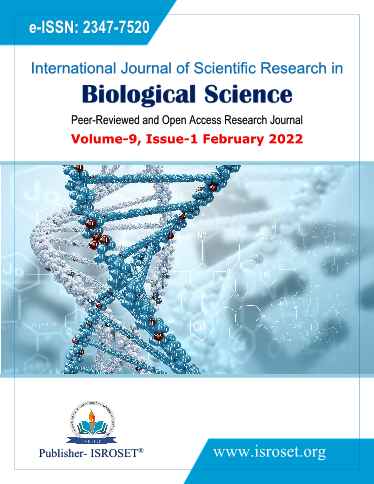Prediction of physic-chemical property/ Biological Activity and ADMET (absorption, distribution, mechanism, excretion, and toxicity) parameters of approved HIV Medications
Keywords:
HIV, Drug –likeness analysis, toxicity estimationAbstract
The purpose of this short study is to estimate the main chemical-physical properties, pharmacokinetics, and biological activity of the main anti-HIV drugs. The ADMETlab, pkCSM server, and The Pass Online Server were used to complete this computational investigation. The canonical SMILES strings of these compounds were retrieved from PubChem (http://pubchem.ncbi.nlm.nih.gov/) using their CAS registry number or chemical name(s). Regarding the in Silico toxicity study, between all the HIV antivirals investigated, “Lamivudine/Zidovudine”, sold under the brand name “Combivir”, reported good overall values, indicating that it is potentially the least toxic, except for the Minnow toxicity parameter (LC50 with a value of about 7.025 (log mM). Furthermore, Lopinavir also reported overall acceptable values against the various toxicity tests, except that of the Max. tolerated dose (human) with a value of -0.297 (log mg / kg / day in units ), compared to Combivir of 0.684 log mg / kg / day in units. From this evaluation, Combivir is one of the best drugs, manly in terms of toxicity parameters and also it would be useful to focus on discovering similar chemical structures, based on their structure.
References
Tassiopoulos, Katherine, et al. "Sexual risk behavior among youth with perinatal HIV infection in the United States: predictors and implications for intervention development." Clinical Infectious Diseases, Vol.56, Issue.2 , pp.283-290, 2013.
Sharp P. M, Bailes E, Chaudhuri R. R, Rodenburg C. M, Santiago M. O, Hahn B. H. The origins of acquired immune deficiency syndrome viruses: where and when?. Philosophical Transactions of the Royal Society of London. Series B: Biological Sciences, Vol. 356, Issue. 1410, pp. 867-876, 2001.
Levy, J A. Pathogenesis of human immunodeficiency virus infection. Microbiological reviews, Vol. 57, Issue. 1, pp. 183-289, 1993.
Pantaleo G, Graziosi, C, Fauci, A S. The immunopathogenesis of human immunodeficiency virus infection. New England Journal of Medicine,Vol. 328, Issue.5, pp. 327-335, 1993.
Semba R D, Tang A M. Micronutrients and the pathogenesis of human immunodeficiency virus infection. Journal of Nutrition, Vol. 81, Issue. 3, pp. 181-189, 1999.
Barnes P. F, Bloch A. B, Davidson P. T, Snider Jr D. E. Tuberculosis in patients with human immunodeficiency virus infection. New England Journal of Medicine, Vol. 324, Issue. 23, pp.1644-1650, 1991.
Havlir D V, Barnes P F. Tuberculosis in patients with human immunodeficiency virus infection. New England Journal of Medicine, Vol. 340, Issue. 5, pp. 367-373, 1999.
Wasserheit J N. Epidemiologies! Synergy: Interrelationships between Human Immunodeficiency Virus Infection and Other. Sexually transmitted diseases, pp.61-77,1992.
Galvin S R, Cohen, M S. The role of sexually transmitted diseases in HIV transmission. Nature Reviews Microbiology, Vol. 2, Issue. 1, pp.33-42,2004.
Cohen, Myron S. Sexually transmitted diseases enhance HIV transmission: no longer a hypothesis. The Lancet, Vol.351 pp.S5-S7, 1998.
Freed E O. HIV-1 replication. Somatic cell and molecular genetics, Vol. 26, Issue. 1, pp.13-33, 2001.
Wills J W, Craven R C. Form, function, and use of retroviral gag proteins. Aids, Vol. 5, Issue. 6, pp. 639-654,1991.
Lipinski C. A, Lombardo F, Dominy B. W, Feeney P. J. Experimental and computational approaches to estimate solubility and permeability in drug discovery and development settings. Advanced drug delivery reviews, Vol. 2, Issue.1-3, pp. 3-25,1997.
Parasuraman S. Prediction of activity spectra for substances. Journal of pharmacology & pharmacotherapeutics, Vol. 2, Issue.1, pp. 52, 2011.
Lipinski C A. Drug-like properties and the causes of poor solubility and poor permeability. Journal of pharmacological and toxicological methods, Vol. 44, Issue.1 , pp. 235-249, 2000.
Valko, K, Reynolds, Derek P. High-throughput physicochemical and in vitro ADMET screening. Journal of Drug Delivery, Vol. 32, Issue.2 , pp.83-100, 2005.
Wang J. B, Cao D. S, Zhu M. F, Yun Y. H, Xiao N, Liang Y. Z In silico evaluation of logD7. 4 and comparison with other prediction methods. Journal of Chemometrics, Vol. 29, Issue.4 , pp. 389-398, 2015.
Wang, Ning-Ning, et al. ADME properties evaluation in drug discovery: prediction of Caco-2 cell permeability using a combination of NSGA-II and boosting. Journal of chemical information and modeling, Vol. 56, Issue.4, pp.763-773, 2016.
Obach R. S, Baxter J. G, Liston T. E, Silber B. M, Jones B. C, Macintyre F, Wastall P. The prediction of human pharmacokinetic parameters from preclinical and in vitro metabolism data. Journal of Pharmacology and Experimental Therapeutics, Vol. 283, Issue. 1, pp. 46-58, 1997.
Van de Wanterbeemd H, Gifford E. ADMET in silico modelling: towards prediction paradise?. Nature reviews Drug discovery, Vol. 2, Issue. 3, pp. 192-204, 2003.
Zhu H, Martin T. M, Ye L, Sedykh A, Young D. M, Tropsha A. Quantitative structure? activity relationship modeling of rat acute toxicity by oral exposure. Chemical research in toxicology, Vol. Issue. 12, 1913-1921, 2009.
Pires D EV, Blundell T L, Ascher D B. pkCSM: predicting small-molecule pharmacokinetic and toxicity properties using graph-based signatures. Journal of medicinal chemistry, Vol. 58, Issue. 9, pp. 4066-407, 2015.
Downloads
Published
How to Cite
Issue
Section
License

This work is licensed under a Creative Commons Attribution 4.0 International License.
Authors contributing to this journal agree to publish their articles under the Creative Commons Attribution 4.0 International License, allowing third parties to share their work (copy, distribute, transmit) and to adapt it, under the condition that the authors are given credit and that in the event of reuse or distribution, the terms of this license are made clear.







